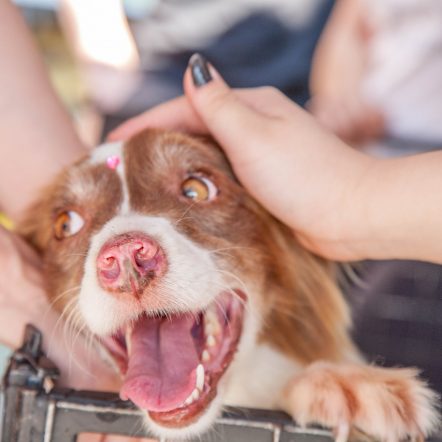Table of Contents
Congratulations on getting a new dog!
When you adopt a new dog you may run into some common problems. Sometimes we have little or no background on them. I wanted to put together a post on what to expect when you bring your newly adopted dog home. Some of the common problems you may run into to.
Remember you have no idea what they have been through in the past. Don’t make the commitment if you are not willing to help your dog get through some of the most common issues and concerns.

Common Problems With New Dogs
Separation Anxiety
Very common in dogs that have spent some time in a shelter. If you notice your dog following you everywhere. Or destructive behavior. This can be a sign they may have some separation anxiety. Practice showing them in short intervals by leaving and coming back a few minutes later. Start slow and keep working with your pet until they barely notice you leave the room.
You can also hire a behavioral specialist or trainer that has experience with such behaviors. You will need to build their confidence so that they won’t feel abandoned again. Work on building that trust by desensitizing your pet.
Chewing
Chewing is natural for dogs. Especially puppies. Teething can be painful for them and chewing provides relief. Your dog may be bored or anxious. You will need to take the time to figure out the cause. Replace the behavior with more chew toys that are safe.
Frozen bones can help with teething as well. Never yell at your dog because they won’t understand. I find that if you encourage a distraction that is more positive. It can be similar to teaching a young child about three years old.
Your dog can be chewing not only from boredom but for stimulation. Make sure you regularly exercise your dog. Take them with you when you can. Chewing can be from all that extra energy they need to burn off. Consistency and patience are the key here.
Elimination In The House
Sometimes when you adopt a dog they may not have been housetrained properly. You will need to start over and show your dog in a patient and repetitious way. Again yelling or hurting your dog for the behavior could actually make things worse. This is one of the main reasons dogs get returned to shelters.
You should always talk to your vet to make sure there are no underlying health problems causing them to have accidents in the home. Some conditions can cause this behavior and its important to rule those out.
Some dogs may be more territorial than others. You will need to correct this behavior in a positive but consistent manner. When you see your dog looking around for a place to go. Take them outside immediately. Check with your dog occasionally after a meal or after they drink a lot of water. When they go outside. Praise them with a very special treat they don’t get on a regular basis.
You can watch this video on Pet MD to help you train your dog from start to finish. Remember you will have to start over and keep consistent.
Begging
It is hard to teach a food-motivated dog not to beg. Most of us encourage the behavior and don’t even realize we are doing so. I use a treat ball during dinner time when we have a lot of people over. When alone you can teach them to stay on a blanket or bed until your done eating. Reward them when they stay. Only if they stay. You can also feed them the same time and when they come to beg, direct them to the spot they are supposed to be. Again rewarding is the key
Dogs are scavengers by nature. So remember this can take time. You can teach them some basic training commands I previously mentioned in my other post.
Aggression
Food Aggression – Can be caused by many things. You may want to hire a Certified Applied Animal Behaviorist. They have a great article on food guarding on the ASPCA website called food guarding. They also have some exercises you can try. I found that if you have another pet in the home try to feed them in separate rooms to avoid any fights. Sometimes feeding them in small amounts more times a day will give them the feeling that there is always more. It can create a dog to be less motivated to guard their food.
People and Dog Aggression – You again should speak to a professional. I have some great tips on how we rehabilitated our rescue dog from fear aggression. Never force an introduction on any dog. Let them make the choice first. Start with simple techniques like avoidance until they are more comfortable.
Biting or Nipping
The most common causes of biting or nipping are related to fear, high prey drive, or dominance. A dog may also bite when they are in pain. So again make sure to speak with your vet. You really need to know your new dog’s body language. Knowing they bite or can nip anyone. You must keep them safe from doing just that. When you take them to the vet consider a soft muzzle to protect your pet and others.
Teach your dog impulse control with some simple training techniques. They depend on you to teach them. They are protective in nature. So try to teach them to control those impulses. Another great article on the ASPCA website has some great techniques to help.
Jumping Up On People
Puppies do this by instinct. Almost every puppy you will meet will do this. They jump up on their mom when they see her so it becomes natural to them. Its a sign of over excitement. Again using distractions and praise can help.
When someone is at your door. Make them sit and stay in a spot so that you can allow your guests to enter. You can also turn the other way ignoring the dog until they stop. This is teaching them how to use self-control. Try not to pet your dog until he is sitting.
Chasing or High Prey Drive
Be aware of what is triggering your dog to chase. Keep your dog on a leash at all times until you have confidence in your dog not to chase. Some breeds of dogs have very high prey drives since they were made for hunting. You can hire a professional depending on how bad the drive is. Try to follow some simple exercises and training techniques to help break the habits.
You can use the leave it command in my basic training for dogs post. This one not only helps them gain self-control but it can also save their life.

Other Resources
For more information on the common problems with new dogs, I also have a great post on what to expect your first night. Some dogs will have come from abusive situations. They may have nightmares. Problems bonding with you. It can take time for them to trust you. Many times it can take up to three weeks for your new dog to feel at home.
Your Commitment
Your commitment to helping new dogs overcome the common problems ultimately depends on you. Some things you may not be able to change, but you can keep them safe. They depend on us to teach them. Dogs do not know the rules until you show them. Developing trust takes time and patience. Before returning any dog back to the shelter be sure you have tried everything. Consult with a professional it will be money well spent. Most of all don’t give up on them. They really do need you to help them.
We hope you enjoyed the article on Common Problems with New Dogs. I have a link below that may help with calming and training your new dog. I also would love to refer you to Your Dog Advisor who can offer you more suggestions in helping with training and other common problems in dogs.









